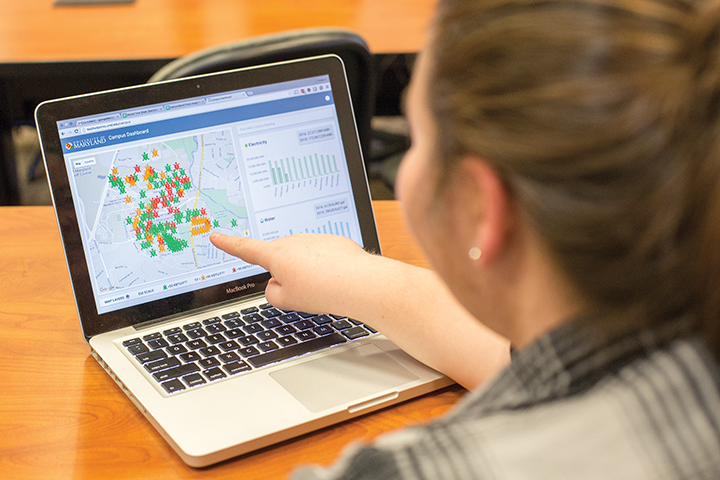Facilities Management has collaborated with CITY@UMD — a university-sponsored group that investigates how University of Maryland infrastructures affect sustainability — to create Campus Dashboard.
Campus Dashboard is an online program that allows anyone with a university ID to log in to the Terp Footprints website and look at the utility usage for each building, It was released to the university public on March 9, but is constantly being worked on.
Students, faculty and staff members have access to each campus building’s electricity and water usage, Facility Operations Manager Chauncey Jenkins said. Some buildings have gas usage statistics, and depending on a building’s heating and cooling system, information on steamed water and chilled water may be available as well.
“Dashboard is for a sustainability purpose without a question,” Jenkins said. “It will engage students and staff about how we use energy on campus, and by doing so I think we have a better chance to reach our climate action goal.” The University of Maryland’s Climate Action Plan outlines how the campus will become carbon neutral by 2050.
Jelena Srebric, director of CITY@UMD and a mechanical engineering professor, spearheaded the project’s creation and said that she has been in the process of developing the platform since January. While Srebric primarily worked on the online platform, Facilities Management was responsible for providing data for each building, utilizing a system they currently use to monitor each building’s utilities.
Data is updated daily, feedback from users is implemented into the dashboard weekly and the software is updated bi-monthly, Srebric said.
“My favorite part is that we created tools for Facilities Management to add and remove buildings themselves,” Srebric said. “As new buildings come online and new technology gets implemented, they are empowered to change the data. Just as we gave data to the community, we gave tools to Facilities Management as well.”
In ENME424 and ENME742: Urban Microclimate and Energy, a combined graduate and undergraduate class Srebric teaches, students utilize the datasets in Campus Dashboard for a semester-long project.
Campus Dashboard has indirectly been in the works for the past five years, Srebric said, and Facilities Management provided $11,000 in funding for the dashboard. The National Science Foundation, where Srebric works as principal investigator, allowed her to use a portion of the $2 million they had previously donated five years ago for projects reducing environmental footprints at Penn State, Harvard and MIT for Campus Dashboard.
Before this university hired her two years ago, Srebric worked on lowering the environmental footprint at the other three universities and even tried to create applications similar to Campus Dashboard. However, she said that “previous attempts to create a dashboard weren’t useful.”
Although there were two or three other dashboard-like systems created before, the difference at this university was that Facilities Management provided feedback on what type of statistics they wanted to see and the frequency of the data, Srebric said.
“These projects provide the foundation for the behavioral as well as our data-enabled operations and maintenance strategies that are aimed at reducing our overall consumption,” said Mary-Ann Ibeziako, director of Facilities Management’s engineering and energy department. “We hope to see a reduction over the next few years of about 3 to 5 percent once the programs are fully developed and deployed.”



